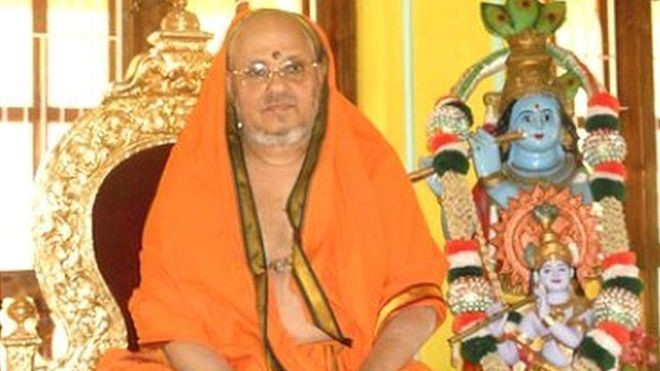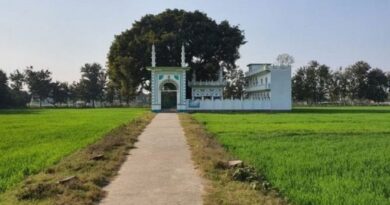Keshavanand Bharti: Dharmaguru, who is called the ‘Protector of the Constitution’, dies
Keshavanand Bharti, the chief petitioner of the historic decision that laid down the ‘Basic Structure Principle’ of the Constitution, has passed away. He was 79 years old.
He breathed his last Sunday morning at his ashram in Idnir, located in Kasargod, northern district of Kerala.
Keshavanand Bharti was the head of the Idnir Math. Mutt’s lawyer IV Bhat told the BBC, “Bharti was to undergo heart valve replacement surgery next week, but died suddenly on Sunday morning.”
The name of Keshavanand Bharti will be recorded in the history of India. 47 years ago, the Supreme Court delivered a landmark judgment in the case of ‘Kesavanand Bharti v State of Kerala’ according to which ‘the basic structure of the Preamble of the Constitution cannot be changed’.
Due to this decision, he was also called the ‘Protector of the Constitution’. However, the subject matter for which he had approached the court was different.
This case became an example
Actually, there is a Hindu monastery called Idnir in Kerala. Kesavananda Bharati was the head of this monastery.
The Ednir Math went to the Supreme Court challenging the land-reform laws of the Kerala government.
Actually, out of 400 acres of the monastery, 300 acres of land was given to the people who were on lease.
He also challenged the 29th Constitution Amendment which included Kerala Land Reforms Act, 1963 in the Ninth Schedule to the Constitution.
Because of this, this law could not be challenged because it would have violated constitutional rights.
Bhat says that “the rights of religious institutions (granted under Article 25 of the Constitution) were taken away by land reform law”.
But Swamiji, also known as the Shankaracharya of Kerala, became a legal challenger to the constitutional rights issue. However, there were some other petitioners in that case.
Through this case, the question came before the Supreme Court in 1973, whether the Parliament had the right to change the original Preamble of the Constitution?
‘Not the math, but people benefit’
While Bharti did not get personal relief in this case, the ‘Kesavanand Bharti vs State of Kerala’ case led to the creation of an important constitutional principle that limited Parliament’s power to amend.
The hearing of the case lasted for 68 days and a 13-judge bench headed by Chief Justice SM Sikri pronounced this historic decision.
Although the opinion of the judges was divided on this, seven judges out of the 13 judges ‘bench decided by majority that’ Parliament has the power to amend the Constitution but the basic structure of the Preamble of the Constitution cannot be changed and No amendment can be against the spirit of the preamble. ‘
This case was also historical because it considered the Constitution to be paramount.
Judicial review, secularism, free electoral system and democracy were called the basic structure of the Constitution and it was clarified that the powers of Parliament cannot disturb the basic structure of the Constitution, the Preamble of the Constitution is its soul and the entire Constitution is based on it.
Math’s lawyer Bhat says that despite the fame of the Kesavanand Bharti case, the Math did not benefit from it, but the people of India benefited from it.
Foreign courts also took inspiration
Many foreign constitutional courts also took inspiration from the historic decision in Kesavananda Bharti vs State of Kerala case.
Many foreign courts cited this historic decision.
According to Live Law, 16 years after Kesavananda’s decision, the Supreme Court of Bangladesh also recognized the original structure doctrine in Anwar Hussain Chaudhary v. Bangladesh.
In the case of Berry M. Bowen v. Attorney General of Belize, the Belize court relied on the Keshavanand case and the IR Coelho case to adopt the basic structure doctrine.
The Keshavanand case also attracted the attention of the African continent. Kenya, African country Uganda, African island- Seychelles cases also expressed confidence by referring to the historical decision of Keshavanand case.
Why was the decision so historical
Senior Supreme Court advocate Sanjay Hegde told BBC Hindi, “Originally the Kesavanand Bharti case ensured that judicial review could be done. The basic structure is the Laxman Rekha, beyond which the government cannot revise the constitution.”
Another Supreme Court lawyer Kaliswaran Raj said, “Our constitution has everything except a prohibitive clause. Like the ‘Eternity Clause’ in the German Constitution under which you cannot change the basic structure of the constitution. This clause would fill that gap. is.”
Raj also states, “The decision in this case is, in fact, the first example of judicial activism in India that we have not seen before with the contributions of Justice VR Krishna Iyer and Justice PN Bhagwati. This case has led to a synthesis of the Constitution. Legislation made. You will get a lot of creativity in this decision. “
At the same time, Hegde says, “On that day (24 April 1973), there were incidents of uniting India. First came the decision in the Kesavanand Bharti case and the second day Sachin Tendulkar was born.”


